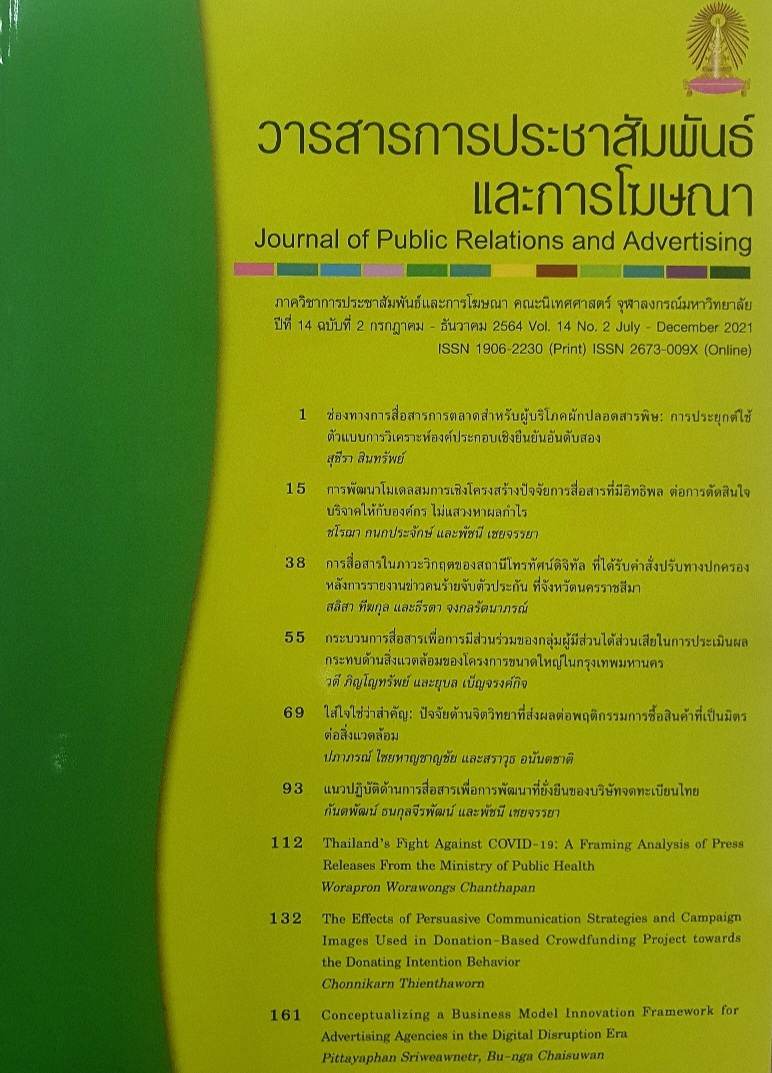Communication Guidelines for Sustainable Development of Thai Listed Companies
Main Article Content
Abstract
The research objectives are to understand the communication process in order to create the Communication Guidelines for Sustainable Development based on system theory and relevant conceptual frameworks. This is a qualitative research which relies on data analyzed from published data by the organizations as well as in-depth interviews with executives and employees who work in Thai Listed Companies recognized for outstanding sustainability performance in 2019. The number of key informants in this research is 28 from 8 companies and 8 related agencies.
The results show that there are numerous input factors for communication for sustainable development of Thai Listed Companies, namely, the sustainability management structure, the vision, mission, and values, Sustainability Policies and Practices, Materiality Analysis and Assessment, corporate strategy and planning, and analysis of stakeholders’ expectations. These input factors are such important information for the communication process since they lead to formulate and design messages, to plan channel strategies, and to process communication for sustainable development eventually. While the output factors are perception and understanding, friendly-innovation for social and environment, Risk and Crisis Management, Disclosure and Transparency, etc. The outcome factors include satisfaction, confidence and acceptance, corporate image and reputation, engagement and loyalty, creating shared value, managing stakeholders’ needs and expectations, crisis adaptation, balanced sustainability in all dimensions, etc.
Communication for sustainable development can be regarded as being unique as it is created to maintain balance in all dimensions of sustainability, which also promotes the transformation of ideas, methods, and work processes for both oneself and the organization. These transformations aim to lead social and environmental changes not only in the country but also in the world society continuously. Therefore, communication for sustainable development can be considered as “the communication for changes”.
Article Details
References
คณะอนุกรรมการขับเคลื่อนเป้าหมายการพัฒนาที่ยั่งยืน. (2561). รายงานผลการทบทวนการดำเนินการตามวาระการพัฒนาที่ยั่งยืน ค.ศ. 2530 ระดับชาติโดยสมัครใจของไทย พ.ศ. 2561. วันที่เข้าถึงข้อมูล 28 พฤศจิกายน 2563, เแหล่งที่มา http://www.mfa.go.th/sep4sdgs/en/articles/70263-SEP-Publications-and-eBooks.html
ณัชฎา คงศรี. (2560). จาก MDGs สู่ SDGs เป้าหมายการพัฒนาที่เปลี่ยนไปเพื่อความยั่งยืน. วันที่เข้าถึงข้อมูล 28 พฤศจิกายน 2563, เแหล่งที่มา https://sdgmove.wordpress.com/2017/08/13/mdgstosdgs/
ณัฐศิริ บุญชวน. (2562). การกำหนดตัวชี้วัดผลการดำเนินงานด้านความยั่งยืน. วันที่เข้าถึงข้อมูล 28 พฤศจิกายน 2563, เแหล่งที่มา https://www.setsustainability.com/download/yz31wdmt64gq7jf
ธิราภร ย้อยแสง. (2555). การใช้ทฤษฎีระบบในการกำหนดนโยบายและแผนประชาสัมพันธ์รถยนต์ มิตซูบิชิ มิราจ ใหม่. วิทยานิพนธ์ปริญญาศิลปศาสตรมหาบัณฑิต สถาบันบัณฑิตพัฒนาบริหารศาสตร์.
ตลาดหลักทรัพย์แห่งประเทศไทย. (2557). ไขความหมายการพัฒนาอย่างยั่งยืน. กรุงเทพฯ: ศูนย์พัฒนาความรับผิดชอบต่อสังคม ตลาดหลักทรัพย์แห่งประเทศไทย.
ตลาดหลักทรัพย์แห่งประเทศไทย. (2560). Sustainable development showcases 2017. กรุงเทพฯ: บริษัทอมรินทร์พริ้นติ้งแอนด์พับลิซซิ่ง จำกัด (มหาชน).
บูรพาทิศ พลอยสุวรรณ์. (2539). การวิเคราะห์ระบบการพัฒนาผู้บริหารโรงเรียนของสำนักงานคณะกรรมการการประถมศึกษาแห่งชาติ. วิทยานิพนธ์ปริญญาครุศาสตรดุษฎีบัณฑิต จุฬาลงกรณ์มหาวิทยาลัย.
ประสงค์ กัลป์ยาณะธรรม. (2550). การวิเคราะห์กระบวนการกำหนดนโยบายศึกษาในแผนพัฒนาเศรษฐกิจและสังคมแห่งชาติ ฉบับที่ 10. วิทยานิพนธ์ปริญญาครุศาสตรดุษฎีบัณฑิต จุฬาลงกรณ์มหาวิทยาลัย.
พนม คลี่ฉายา. (2561). หลัก เทคนิค และวิธีการประเมินผลการประชาสัมพันธ์. กรุงเทพฯ: โครงการตำรา คณะนิเทศศาสตร์ จุฬาลงกรณ์มหาวิทยาลัย.
พิพัฒน์ ยอดพฤติการณ์. (2556). CSR กับการพัฒนาที่ยั่งยืน. วารสารเศรษฐศาสตร์สุโขทัยธรรมาธิราช, 6(2), 1-10.
รุ่งรัตน์ ชัยสำเร็จ. (2558). การสื่อสารองค์กร : แนวคิดการสร้างชื่อเสียงอย่างยั่งยืน = Corporate Communication : Strategic Concepts for Sustainability Reputation. กรุงเทพฯ: โรงพิมพ์แห่งจุฬาลงกรณ์มหาวิทยาลัย.
สถาบันคลังสมองของชาติ. (2561). โครงการส่งเสริมการร่วมขับเคลื่อนเป้าหมายการพัฒนาที่ยั่งยืนของอุดมศึกษาและหุ้นส่วนเพื่อการพัฒนา. กรุงเทพฯ: สถาบันคลังสมองของชาติ.
สำนักงานคณะกรรมการกำกับหลักทรัพย์และตลาดหลักทรัพย์. (2560). การกำกับดูแลกิจการที่ดีและการพัฒนากิจการเพื่อความยั่งยืน. วันที่เข้าถึงข้อมูล 28 พฤศจิกายน 2563, เแหล่งที่มา https://www.sec.or.th/cgthailand/th/pages/overview/cgandsustainablebusinessdevelopment.aspx
สำนักงานคณะกรรมการพัฒนาการเศรษฐกิจและสังคมแห่งชาติ. (2559). แผนพัฒนาเศรษฐกิจและสังคมแห่งชาติ ฉบับที่สิบสอง พ.ศ. ๒๕๖๐ - ๒๕๖๔. กรุงเทพฯ: สำนักนายกรัฐมนตรี.
สำนักงานคณะกรรมการพัฒนาการเศรษฐกิจและสังคมแห่งชาติ. (2546). การพัฒนาที่ยั่งยืนในบริบทไทย. เอกสารประกอบการประชุมประจำปี 2546 การพัฒนาที่ยั่งยืน. กรุงเทพฯ: สำนักงานคณะกรรมการพัฒนาการเศรษฐกิจและสังคมแห่งชาติ.
สำนักงานเลขานุการของคณะกรรมการยุทธศาสตร์ชาติ. (2561). ยุทธศาสตร์ชาติ พ.ศ. ๒๕๖๑ - ๒๕๘๐ (ฉบับประกาศราชกิจจานุเบกษา). กรุงเทพฯ: สำนักงานคณะกรรมการพัฒนาเศรษฐกิจและสังคมแห่งชาติ.
Ahlin, K. (2019). Measuring the Immeasurable? The Intangible Benefits of Digital Information Information Security and Privacy in Business and Society, 6176-6185. doi:10.24251/HICSS.2019.743
Business and Sustainable Development Commission. (2017). Better Business Better World. London: Business and Sustainable Development Commission.
BWD. (2020). Don’t report sustainability – communicate it!. Retrieved November 28, 2020, from https://bwdstrategic.com/thoughts/dont-report-sustainability-communicate/
Dalal-Clayton, B., & Bass, S. (2002). Sustainable Development Strategies: A Resource Book. New York: Organisation for Economic Co-operation and Development.
GRI. (2015). Item 20 – Transition to GRI Standards 2: Content Principles. Retrieved November 28, 2020 from Amsterdam: https://www.globalreporting.org/standards/media/2335/item-20-transition-to-gri-standards-mock-up-of-sustainability-reporting-standard-2-content-principles.pdf
GRI, UN Global Compact, & WBCSD. (2016). SDG Compass: The guide for business action on the SDGs. Retrieved from https://sdgcompass.org/
Jones, E. (2005). A systems approach to an into organizational communication within the Fire and Emergency Services Authority of Western Australia: An action research study: Edith Cowan University.
Miller, K. (2012). Organizational Communication: Approaches and Processes (6 ed.). USA: Lyn Uhl.
Parsons, J., Gokey, C., & Thornton, M. (2013). Indicators of Inputs, Activities, Outputs, Outcomes and Impacts in Security and Justice Programming. UK: Conflict, Crime, and Violence Results Initiative (CCVRI).
Riel, C. B. M. V. (1992). Principles of corporate communication. London: Prentice Hall.
Riel, C. B. M. V., & Fombrun, C. J. (2007). Essentials of Corporate Communication: Implementing practices for effective reputation management. USA: Routledge.
Kuntasuwun, R. (2018). Strategic Sustainability Communication Model of Listed Companies in the Stock Exchange of Thailand. (Doctor of Philosophy). National Institute of Development Administration, Bangkok.
Scott, W. R., & Davis, G. F. (2016). Organizations and Organizing: Rational, Natural, and Open System Perspectives. USA: Routledge.
Tiyarattanachai, R., & Chhang, R. (2019). Perspectives of Thai Listed Companies on the United Nations’ Sustainable Development Goals. IOP Conference Series: Earth and Environmental Science, 265, 1-9. doi:10.1088/1755-1315/265/1/012011
United Nations. (2015). The Global Goals for Sustainable Development. Retrieved November 28, 2020 from https://www.un.or.th/globalgoals/the-goals/
United Nations. (2019). The Sustainable Development Agenda. Sustainable Development. Retrieved November 28, 2020 from https://www.un.org/sustainabledevelopment/development-agenda/
World Health Organization. (2017). WHO Strategic Communications Framework for effective communications. Switzerland: World Health Organization.


